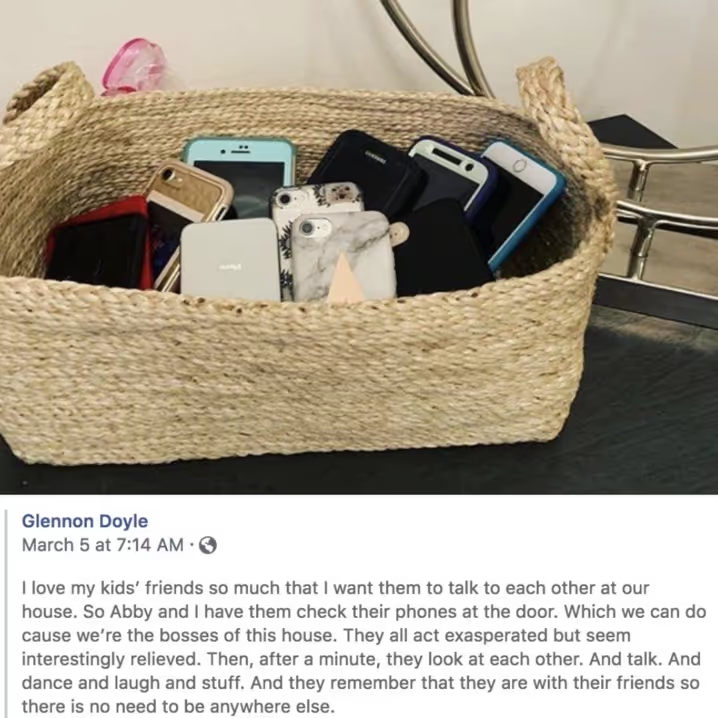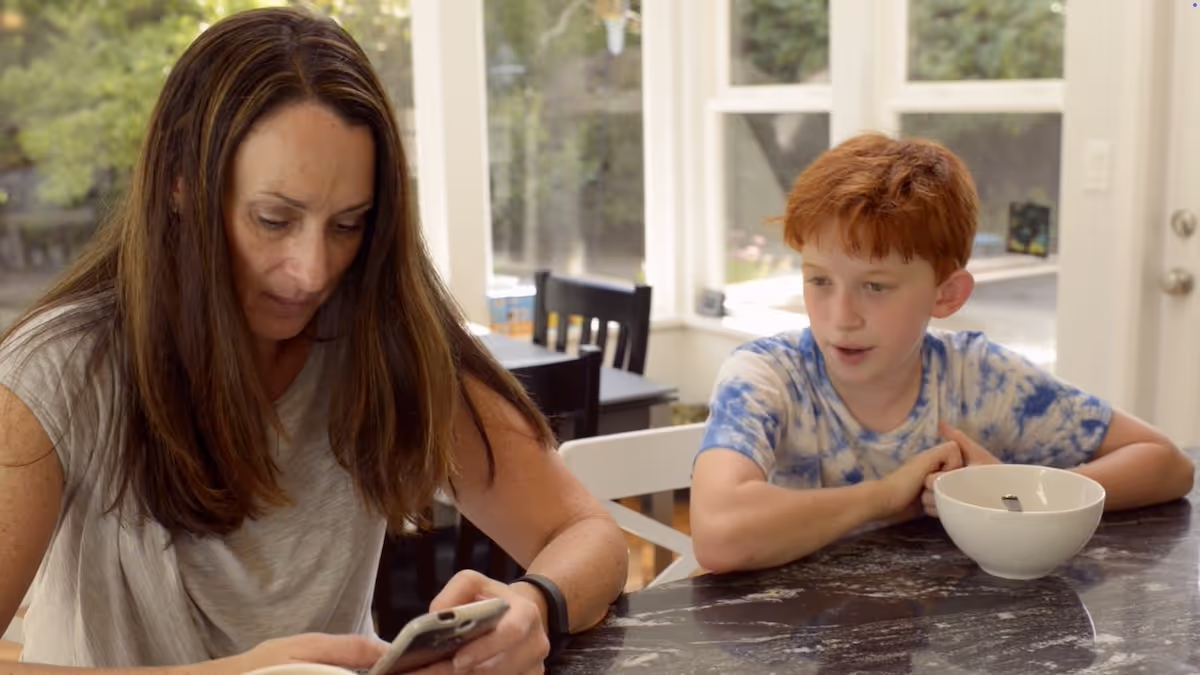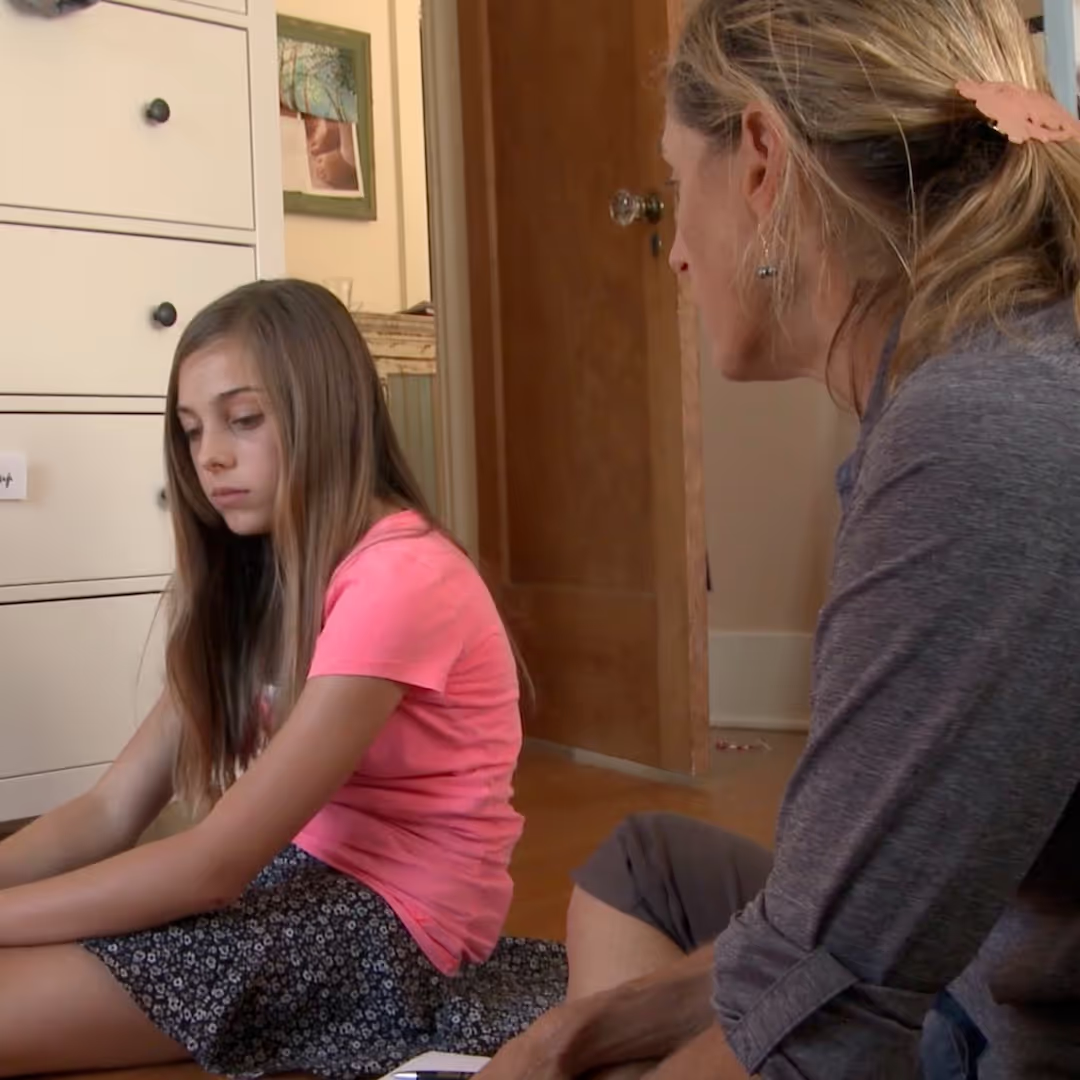



People often ask me how much time is too much. Given that screens have become so pervasive in every place and aspect of our lives, I think that a better way to look at it is all the places and times you decide not to allow screens. Where in the house, in school, outside, might not be great places to have a screen, or at least a cell phone?
Here is one example of something I do: When we are having people over who have kids/teens, I let the guests know, beforehand, that we have a tech-away policy when socializing at our home. That little preamble has helped my kids feel less awkward when guests arrive, and the policy is gently brought up. I try to say something in a joking way like ”I am so glad we all get to share our attention, I know all of our devices will be shouting in the background ‘What about me, what about me?’”
Glennon Doyle, who writes on the merits of being honest and purposeful, posted this picture above on Facebook last week sharing with her fans that when her daughters’ friends come over, they have to deposit their phones in a basket.
When my daughter, Tessa, was younger and she had sleepovers, we would agree beforehand on a reasonable time for devices put away, usually around 11:30. She would tell her friends about the policy before arriving so I wouldn’t embarrass her. Because at 11:30 they would rarely shut off the devices on their own, I usually had to come in to collect them. I always got the sense that at least one or two of them were partly relieved when I put the devices to sleep.
Three years ago my family decided to make car time, screen-free time. There is no question that it has been a great thing for our car conversations. It was a bit touch-and-go when we started. When my kid’s friends would get in the car, I would gently tell them that we have a no cell phone policy in the car. At first, my kids were embarrassed that I would say this. But through our family conversations where we discussed the benefits of such a policy, over time they stopped being annoyed, and they don’t mind my telling their friends—seriously, they don't.
There are clear safety reasons why fewer distractions in the car are good. Distracted driving now causes more accidents than drinking. And yet it is not just about safety. In Australia, a recent survey conducted of a thousand families found that 95% of parents believe a car is a place where kids can open up, and the family can bond. Yet, the parents in the study reported that more than 75% of their children are often on a tablet, phone or other screens, while in the car.
It might be fun to share these cell phone free bans with your kids as a conversation starter: ** On the left side there is a vertical sharing bar and if you click on the printer icon you can print this TTT and bring to the dinner table or any other place you will talk with youth about the TTT.
For this week’s TTT talk to your family and youth about what are the times and places in their day where screens are not allowed:
We would love for you to share this TTT any way that works for you, whether that’s on social media or via a newsletter. If you want to send it out in your newsletter we just ask that you credit us and link to our website, and let us know at lisa@screenagersmovie.com.
HOST A SCREENING to help spark change.
FIND EVENT LISTINGS
Do you organize professional development in schools? We now have a 6-hour, 3-part training module. Request more information here Professional Development.
Stay in touch with the Screenagers community on Facebook, Twitter and leave comments below.
Here are 3 other TTTs you might be interested in:
Siblings and Screentime
When Kids Swear Online
Teens Build Communication Skills by Working
Here is a video from the Screenagers YouTube Channel that talks more about this subject
Learn more about showing our movies in your school or community!
Join Screenagers filmmaker Delaney Ruston MD for our latest Podcast

Learn more about our Screen-Free Sleep campaign at the website!
Our movie made for parents and educators of younger kids
Learn more about showing our movies in your school or community!
Learn more about showing our movies in your school or community!
Join Screenagers filmmaker Delaney Ruston MD for our latest Podcast

Learn more about our Screen-Free Sleep campaign at the website!
Our movie made for parents and educators of younger kids
Join Screenagers filmmaker Delaney Ruston MD for our latest Podcast
As we’re about to celebrate 10 years of Screenagers, we want to hear what’s been most helpful and what you’d like to see next.
Please click here to share your thoughts with us in our community survey. It only takes 5–10 minutes, and everyone who completes it will be entered to win one of five $50 Amazon vouchers.

People often ask me how much time is too much. Given that screens have become so pervasive in every place and aspect of our lives, I think that a better way to look at it is all the places and times you decide not to allow screens. Where in the house, in school, outside, might not be great places to have a screen, or at least a cell phone?
Here is one example of something I do: When we are having people over who have kids/teens, I let the guests know, beforehand, that we have a tech-away policy when socializing at our home. That little preamble has helped my kids feel less awkward when guests arrive, and the policy is gently brought up. I try to say something in a joking way like ”I am so glad we all get to share our attention, I know all of our devices will be shouting in the background ‘What about me, what about me?’”
Glennon Doyle, who writes on the merits of being honest and purposeful, posted this picture above on Facebook last week sharing with her fans that when her daughters’ friends come over, they have to deposit their phones in a basket.
When my daughter, Tessa, was younger and she had sleepovers, we would agree beforehand on a reasonable time for devices put away, usually around 11:30. She would tell her friends about the policy before arriving so I wouldn’t embarrass her. Because at 11:30 they would rarely shut off the devices on their own, I usually had to come in to collect them. I always got the sense that at least one or two of them were partly relieved when I put the devices to sleep.
Three years ago my family decided to make car time, screen-free time. There is no question that it has been a great thing for our car conversations. It was a bit touch-and-go when we started. When my kid’s friends would get in the car, I would gently tell them that we have a no cell phone policy in the car. At first, my kids were embarrassed that I would say this. But through our family conversations where we discussed the benefits of such a policy, over time they stopped being annoyed, and they don’t mind my telling their friends—seriously, they don't.
There are clear safety reasons why fewer distractions in the car are good. Distracted driving now causes more accidents than drinking. And yet it is not just about safety. In Australia, a recent survey conducted of a thousand families found that 95% of parents believe a car is a place where kids can open up, and the family can bond. Yet, the parents in the study reported that more than 75% of their children are often on a tablet, phone or other screens, while in the car.
It might be fun to share these cell phone free bans with your kids as a conversation starter: ** On the left side there is a vertical sharing bar and if you click on the printer icon you can print this TTT and bring to the dinner table or any other place you will talk with youth about the TTT.
For this week’s TTT talk to your family and youth about what are the times and places in their day where screens are not allowed:
We would love for you to share this TTT any way that works for you, whether that’s on social media or via a newsletter. If you want to send it out in your newsletter we just ask that you credit us and link to our website, and let us know at lisa@screenagersmovie.com.
HOST A SCREENING to help spark change.
FIND EVENT LISTINGS
Do you organize professional development in schools? We now have a 6-hour, 3-part training module. Request more information here Professional Development.
Stay in touch with the Screenagers community on Facebook, Twitter and leave comments below.
Here are 3 other TTTs you might be interested in:
Siblings and Screentime
When Kids Swear Online
Teens Build Communication Skills by Working
Here is a video from the Screenagers YouTube Channel that talks more about this subject
Sign up here to receive the weekly Tech Talk Tuesdays newsletter from Screenagers filmmaker Delaney Ruston MD.
We respect your privacy.

People often ask me how much time is too much. Given that screens have become so pervasive in every place and aspect of our lives, I think that a better way to look at it is all the places and times you decide not to allow screens. Where in the house, in school, outside, might not be great places to have a screen, or at least a cell phone?
Here is one example of something I do: When we are having people over who have kids/teens, I let the guests know, beforehand, that we have a tech-away policy when socializing at our home. That little preamble has helped my kids feel less awkward when guests arrive, and the policy is gently brought up. I try to say something in a joking way like ”I am so glad we all get to share our attention, I know all of our devices will be shouting in the background ‘What about me, what about me?’”
Glennon Doyle, who writes on the merits of being honest and purposeful, posted this picture above on Facebook last week sharing with her fans that when her daughters’ friends come over, they have to deposit their phones in a basket.
When my daughter, Tessa, was younger and she had sleepovers, we would agree beforehand on a reasonable time for devices put away, usually around 11:30. She would tell her friends about the policy before arriving so I wouldn’t embarrass her. Because at 11:30 they would rarely shut off the devices on their own, I usually had to come in to collect them. I always got the sense that at least one or two of them were partly relieved when I put the devices to sleep.
Three years ago my family decided to make car time, screen-free time. There is no question that it has been a great thing for our car conversations. It was a bit touch-and-go when we started. When my kid’s friends would get in the car, I would gently tell them that we have a no cell phone policy in the car. At first, my kids were embarrassed that I would say this. But through our family conversations where we discussed the benefits of such a policy, over time they stopped being annoyed, and they don’t mind my telling their friends—seriously, they don't.
There are clear safety reasons why fewer distractions in the car are good. Distracted driving now causes more accidents than drinking. And yet it is not just about safety. In Australia, a recent survey conducted of a thousand families found that 95% of parents believe a car is a place where kids can open up, and the family can bond. Yet, the parents in the study reported that more than 75% of their children are often on a tablet, phone or other screens, while in the car.
It might be fun to share these cell phone free bans with your kids as a conversation starter: ** On the left side there is a vertical sharing bar and if you click on the printer icon you can print this TTT and bring to the dinner table or any other place you will talk with youth about the TTT.
For this week’s TTT talk to your family and youth about what are the times and places in their day where screens are not allowed:
We would love for you to share this TTT any way that works for you, whether that’s on social media or via a newsletter. If you want to send it out in your newsletter we just ask that you credit us and link to our website, and let us know at lisa@screenagersmovie.com.
HOST A SCREENING to help spark change.
FIND EVENT LISTINGS
Do you organize professional development in schools? We now have a 6-hour, 3-part training module. Request more information here Professional Development.
Stay in touch with the Screenagers community on Facebook, Twitter and leave comments below.
Here are 3 other TTTs you might be interested in:
Siblings and Screentime
When Kids Swear Online
Teens Build Communication Skills by Working
Here is a video from the Screenagers YouTube Channel that talks more about this subject


Parenting in this digital age is full of challenges. I imagine many of you are nodding in agreement. And when we look for advice online, it can feel like a sea of perfect experts with perfect advice: “Just follow these three easy steps and everything will fall into place.” In this week’s blog, I share a story about a moment with my daughter Tessa that did not go quite as planned but ended up teaching us both something important.
READ MORE >
Wow! Summer really goes by fast, doesn’t it? Back-to-school is already here for some and not far away for others. Ahead of this school year, I’ve hand-picked four of our most useful blogs. Practical, timely guides to help you set your family up for a healthier, more balanced relationship with technology in the months ahead.
READ MORE >for more like this, DR. DELANEY RUSTON'S NEW BOOK, PARENTING IN THE SCREEN AGE, IS THE DEFINITIVE GUIDE FOR TODAY’S PARENTS. WITH INSIGHTS ON SCREEN TIME FROM RESEARCHERS, INPUT FROM KIDS & TEENS, THIS BOOK IS PACKED WITH SOLUTIONS FOR HOW TO START AND SUSTAIN PRODUCTIVE FAMILY TALKS ABOUT TECHNOLOGY AND IT’S IMPACT ON OUR MENTAL WELLBEING.
